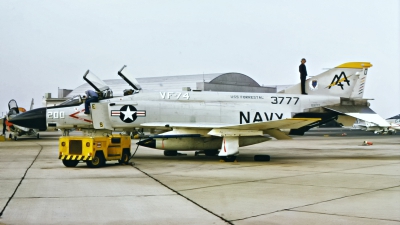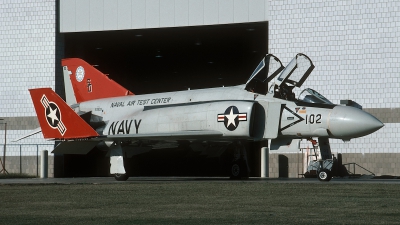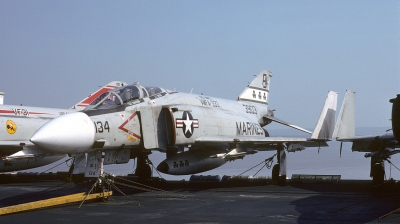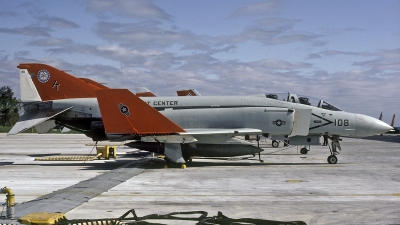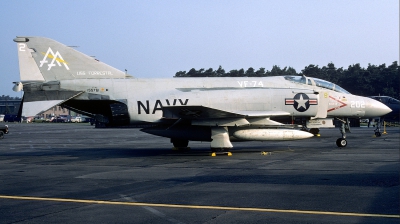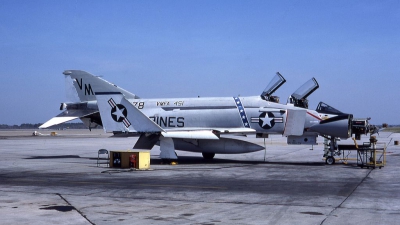McDonnell Douglas F-4J Phantom II Aircraft Data
The F-4J Phantom was the final production version of the mighty Phantom for the US Navy and US Marine Corps and based on the first naval variant, the F-4B. In 1963 the US Navy drew up a specification for the F-4B follow-on, with emphasis placed on the CAP fighter role. Although the J model was planned in parallel with the F-4D for the USAF, it was in many respects a more advanced aircraft. It was also a heavier aircraft, resulting in significant airframe changes. An additional fuel cell was fitted in the rear fuselage to bring the total internal fuel capacity to 1977 USGallons (1347 USG in fuselage tanks and another 630 USG carried internally in wing tanks). However, the number 1 fuel cell was slightly reduced in size to accommodate onboard computers and other electronics.
The increase in weight necessitated a strengthened landing gear with larger mainwheels. These were stressed for recovery at 38,000 lbs, at a 23.3 ft/second sink rate. In order to accommodate these, the upper and lower surfaces of the inner wing had to be bulged outward like those seen on the USAF F-4C. As a result of the aerodynamic innovations, the approach speed was reduced from 157 mph to 144mph (136.4 kts to 125 kts).
To handle the increased weight, the F-4J was powered by a pair of General Electric J79-GE-10 engines, rated at an afterburning thrust of 17,900 pounds (79.65 kN) each. At Mach 2 at 36,000 feet the GE-10s produced more than 2,000 lbs more thrust each than these on the F-4B. The GE-10 engines were externally distinguishable by their longer afterburner 'turkey feathers', compared to those of the F-4B's GE-8A and B turbojets.
The most important feature of the F-4J however was its weapons system, centered around the Westinghouse new pulse-doppler radar, the APG-59. It was incorporated into a new integrated missile control system designated AN/AWG-10, enabling the acquisistion and tracking of both high and low flying targets. The F-4J was fitted with the AN/ASW-25 one-way datalink which made automatic carrier landings possible. This system, in an earlier version, the AN/ASW-21, had been trialled in the F-4G (these were 12 F-4B aircraft modified on the production line to incorporate the ASW-21 two-way digital datalink). The fitment of this equipment was intended to link the Phantom with AEW aircraft and ship-based radar to enable fighter/interceptor control without voice control. The system allowed to make fully automatic carrier landings.
The F-4J was equipped with the miniaturised solid-state AN/AJB-7 bombing system which provided substantially better ground attack capability over that of the F-4B. It had the capability for all-altitude release of nuclear weapons and the capability of operating the Bullpup air-to-surface missile. From 1969, Sidewinder Expanded Acquisition Mode (SEAM) was provided. This involved new wiring and the fitting of other items designed to make full use of upgraded Sidewinder missiles. The Visual Target Acquisition System (VTAS) helmet sight was fitted to Blocks 45-MC and 46-MC, and was later retrofitted to most remaining earlier aircraft. Another retrofit was the AN/ALQ-126 ECM system manufactured by Sanders, as well as the fitting of AN/APX-76 or -89 IFF equipment.
For test and development purposes three F-4B airframes were converted into YF-4J prototypes: BuAerNo. 151473, 151496, and 151497. The first prototype YF-4J took to the air on 4 June, 1965 to be followed in less than a year by the first production F-4J (first flight on 27 May 27, 1966). Another 521 production examples, built between December 1966 and January 1972 would follow. The first F-4J deliveries to the US Navy began on 1 October, 1966, with the first operational unit, VF-101 'Grim Reapers' to receive their first aircraft in December of that year. They rapidly began to replace the earlier F-4B in most operational Navy squadrons. The first Marine Corps unit to receive the F-4J was VMFA-334, which began to receive the type in June of 1967. VMFA-334 was deployed to Chu Lai, RVN with VMFA-232 quickly to follow in the beginning of 1969. The last of the 522 F-4Js was delivered in 1972.
In 1976 a modification programme to convert 302 F-4Js to F-4S standard commenced at the Naval Air Rework Facility (NARF) at NAS North Island, San Diego. Aimed to provide more structural strength, a longer fatigue life, updated mission equipment (AN/AWG10 to AN/AGW-10B radar), rewiring and a new slatted wing. Eventually 265 aircraft were modified to F-4S standard.
The increase in weight necessitated a strengthened landing gear with larger mainwheels. These were stressed for recovery at 38,000 lbs, at a 23.3 ft/second sink rate. In order to accommodate these, the upper and lower surfaces of the inner wing had to be bulged outward like those seen on the USAF F-4C. As a result of the aerodynamic innovations, the approach speed was reduced from 157 mph to 144mph (136.4 kts to 125 kts).
To handle the increased weight, the F-4J was powered by a pair of General Electric J79-GE-10 engines, rated at an afterburning thrust of 17,900 pounds (79.65 kN) each. At Mach 2 at 36,000 feet the GE-10s produced more than 2,000 lbs more thrust each than these on the F-4B. The GE-10 engines were externally distinguishable by their longer afterburner 'turkey feathers', compared to those of the F-4B's GE-8A and B turbojets.
The most important feature of the F-4J however was its weapons system, centered around the Westinghouse new pulse-doppler radar, the APG-59. It was incorporated into a new integrated missile control system designated AN/AWG-10, enabling the acquisistion and tracking of both high and low flying targets. The F-4J was fitted with the AN/ASW-25 one-way datalink which made automatic carrier landings possible. This system, in an earlier version, the AN/ASW-21, had been trialled in the F-4G (these were 12 F-4B aircraft modified on the production line to incorporate the ASW-21 two-way digital datalink). The fitment of this equipment was intended to link the Phantom with AEW aircraft and ship-based radar to enable fighter/interceptor control without voice control. The system allowed to make fully automatic carrier landings.
The F-4J was equipped with the miniaturised solid-state AN/AJB-7 bombing system which provided substantially better ground attack capability over that of the F-4B. It had the capability for all-altitude release of nuclear weapons and the capability of operating the Bullpup air-to-surface missile. From 1969, Sidewinder Expanded Acquisition Mode (SEAM) was provided. This involved new wiring and the fitting of other items designed to make full use of upgraded Sidewinder missiles. The Visual Target Acquisition System (VTAS) helmet sight was fitted to Blocks 45-MC and 46-MC, and was later retrofitted to most remaining earlier aircraft. Another retrofit was the AN/ALQ-126 ECM system manufactured by Sanders, as well as the fitting of AN/APX-76 or -89 IFF equipment.
For test and development purposes three F-4B airframes were converted into YF-4J prototypes: BuAerNo. 151473, 151496, and 151497. The first prototype YF-4J took to the air on 4 June, 1965 to be followed in less than a year by the first production F-4J (first flight on 27 May 27, 1966). Another 521 production examples, built between December 1966 and January 1972 would follow. The first F-4J deliveries to the US Navy began on 1 October, 1966, with the first operational unit, VF-101 'Grim Reapers' to receive their first aircraft in December of that year. They rapidly began to replace the earlier F-4B in most operational Navy squadrons. The first Marine Corps unit to receive the F-4J was VMFA-334, which began to receive the type in June of 1967. VMFA-334 was deployed to Chu Lai, RVN with VMFA-232 quickly to follow in the beginning of 1969. The last of the 522 F-4Js was delivered in 1972.
In 1976 a modification programme to convert 302 F-4Js to F-4S standard commenced at the Naval Air Rework Facility (NARF) at NAS North Island, San Diego. Aimed to provide more structural strength, a longer fatigue life, updated mission equipment (AN/AWG10 to AN/AGW-10B radar), rewiring and a new slatted wing. Eventually 265 aircraft were modified to F-4S standard.
- Country of Origin: USA
- First Flight:
- Initial Service Date:
- No. Built: 522
- No. In Service: 0
- No. of Hardpoints: 9
- Crew: 2
Power:
Two General Electric J79-GE-10B turbojets at 11,870 lbf
Weapons:
Four AIM-9 Sidewinder air-to-air missiles on double rails on the inboard wing stations.
Four AIM-7 Sparrow air-to-air missiles, semi-recessed in bays under the fuselage.
On the centreline station a 600 USG (2,271 litres/4,020 lbs) fuel tank could be carried.
On the outboard wing stations a 370 USG (1,400 litres/2,479 lbs) fuel tank could be carried.
Four AIM-7 Sparrow air-to-air missiles, semi-recessed in bays under the fuselage.
On the centreline station a 600 USG (2,271 litres/4,020 lbs) fuel tank could be carried.
On the outboard wing stations a 370 USG (1,400 litres/2,479 lbs) fuel tank could be carried.
Dimensions:
| Length: | 58 ft 3 3/4 in. |
| Wing Span: | 38 ft 5 in. |
| Wing Area: | 530 sq.ft |
| Height: | 16 ft 3 in. |
| Empty Weight: | 30,770 lbs |
| Max. Weight: | 58,000 lbs |
| Max. Ordnance Load: | 16,000 lbs |
| Internal Fuel: | 13,245 lbs |
Performance:
| Max. Speed: | 1,434 mph |
| Service Ceiling: | 61.900 ft. |
| Max. Range: | 1,699 nm |
Operators:
USAThe F-4J Phantom served with the following US Navy and US Marine Corps units:
US Navy Atlantic Fleet units:
VF-11, VF-31, VF-32, VF-33, VF-41, VF-74, VF-84, VF-101, VF-102, VF-103.
US Navy Pacific Fleet units:
VF-21, VF-92, VF-96, VF-114, VF-121, VF-142, VF-143, VF-151, VF-154, VF-161, VF-191, VF-194, VF-213.
US Marine Corps units:
VMFA-112, VMFA-115, VMFA-122, VMFA-212, VMFA-232, VMFA-235, VMFA-312, VMFA-333, VMFA-334, VMFA-451, VMMAT-201, and VMFAT-101.
United Kingdom
In 1984 fifteen former US Navy/US Marine Corps F-4J transferred to the Royal Air Force for service with No.74 Squadron, based at RAF Wattisham, Suffolk, England. The machines were prepared for the RAF at the Naval Air Rework Facility at NAS North Island, San Diego. The first three machines arrived on 30 August 1984, the last on 4 January 1985.
153768 to RAF as ZE350; delivered 5 October 1983; No.74(F) Squadron, 'T'
153773 to RAF as ZE351; delivered 4 January 1985; No.74(F) Squadron, 'I'
153783 to RAF as ZE352; delivered 30 August 1984; No.74(F) Squadron, 'G'
153785 to RAF as ZE353; delivered 4 October 1984; No.74(F) Squadron, 'E'
153795 to RAF as ZE354; delivered 30 August 1984; No.74(F) Squadron, 'R'
153803 to RAF as ZE355; delivered 4 October 1984; No.74(F) Squadron, 'S'
153850 to RAF as ZE356; delivered 26 November 1984; No.74(F) Squadron, 'Q'
153892 to RAF as ZE357; delivered 1 November 1984; No.74(F) Squadron, 'N'
155510 to RAF as ZE358; delivered 13 December 1984; No.74(F) Squadron, 'H'
155529 to RAF as ZE359; delivered 30 August 1984; No.74(F) Squadron, 'J'
155574 to RAF as ZE360; delivered 13 December 1984; No.74(F) Squadron, 'O'
155734 to RAF as ZE361; delivered 1 November 1984; No.74(F) Squadron, 'P'
155755 to RAF as ZE362; delivered 26 November 1984; No.74(F) Squadron, 'V'
155868 to RAF as ZE363; delivered 1 November 1984; No.74(F) Squadron, 'W'
155894 to RAF as ZE364; delivered 26 November 1984; No.74(F) Squadron, 'Z'
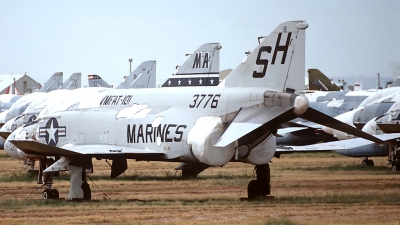
 Random great photos of the McDonnell Douglas F-4J Phantom II:
Random great photos of the McDonnell Douglas F-4J Phantom II:
